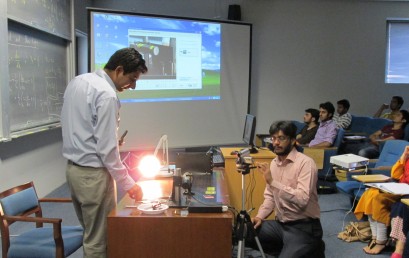

Electromagnetic radiation occurs over an extremely wide range of wavelengths, from gamma rays with wavelengths less than about 1 × 1011 metre to radio waves measured in metres. This can be used as a spectroscopic toola diffraction grating disperses light according to wavelength, for example, and is used to produce spectrabut diffraction also limits the detail we can obtain in images. His record has since been surpassed by NASA astronaut Mark Vande Hei, who reached 353 days on the International Space Station. light, electromagnetic radiation that can be detected by the human eye. Light diffracts as it moves through space, bending around obstacles, interfering constructively and destructively. The law of refraction, also known as Snell’s law, describes the relationship between the angle of incidence ( 1) and the angle of refraction ( 2 ), measured with respect to the normal (perpendicular line) to the surface, in mathematical terms: n1 sin 1 n2 sin 2, where n1 and n2 are the index of refraction of the first and second media. The index of refraction n of a non-magnetic material. If the two waves are in phase their crests will coincide and they will experience interference, producing a wave with a (n) amplitude. magnetic properties of the medium, and the speed of light in. In 2016, Kelly broke the record for the longest consecutive days (340) spent in space. Diffraction is the apparent bending of light around the edge of an object in its path Any two waves that meet as they travel through the same medium will interact.

It turns out it was Bart Simpson - a balloon." "I remember one time I was flying in the warning areas off of Virginia Beach military operating area and my RIO - the guy who sits in the back of the Tomcat - was convinced we flew by a UFO," Kelly said. The first is described by the three-dimensional grating. He described a time when he was flying and his radar intercept office (RIO) thought he spotted a UFO. ABSTRACr In a recently developed theory of light diffraction by single striated muscle fibers. Kelly was part of a panel that convened on Wednesday at NASA headquarters to discuss UFOs, what NASA now refers to as unidentified aerial phenomenon. This phenomenon is known as diffraction of the light, and occurs when a light wave passes very close to the edge of an object or through a tiny opening, such as a slit or aperture. But retired astronaut Scott Kelly is here to tell us that many UFO sightings are probably just our eyes playing tricks on us.

UFOs rev up our imaginations and make us dare to wonder about highly-intelligent life beyond Earth. As the wavelength of light is very small, compared to that of sound. Account icon An icon in the shape of a person's head and shoulders. Since the sound waves have a greater wavelength, the diffraction effects are pronounced.


 0 kommentar(er)
0 kommentar(er)
